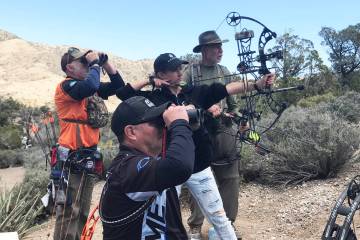Quail hunters can look forward to an average season
Back in October, the Arizona Game and Fish Department put out a quail season forecast that said, “Arizona quail hunters will be glad to know – in fact, they should be thrilled – that the 2020-21 season is shaping up to be average.”
A descriptor like the word average may not seem encouraging, but there are times when average is a good thing.
“Taking everything into account, this will be a great season compared to what we have experienced in the last 15 or more years,” said Johnathan O’Dell, small game biologist for the Arizona Game and Fish Department (AZGFD) in the forecast. “But taking the long view on this one — and the older, seasoned quail hunters will agree — this season will actually be what an average year used to look like in Arizona.”
Without knowing it, a friend of mine and his extended family recently tested the veracity of O’Dell’s statement. Each year, the clan takes a pilgrimage from the Las Vegas area to Arizona just for the quail hunting. This year what they found was a throwback to years gone by. They got into several large coveys, and as my friend shared his brief report, the excitement in his eyes told the rest of the story.
Call surveys conducted by the AZGFD in northwestern Arizona found the highest bird numbers to date. In fact, they were twice as high as those recorded during the past five years. “From a population standpoint, we are out of a deficit for the first time since 2001-2002. Quail are starting to pop up in places they haven’t been seen in a while,” O’Dell said.
Like Southern Nevada, the northwest corner of Arizona also missed out on summer rains, but Brandon Foley, Terrestrial Wildlife Specialist for the AZGFD, said the quail have “fared pretty well. I’m seeing some pretty large coveys. Just today I was flying some of our game waters to check on them, and I think at one of the catchments we estimated 60 birds flew.”
O’Dell credits back-to-back winters with above-average precipitation for the turnaround. Foley agrees. “I think our winter moisture really helped out the populations,” he said.
Since this is an average year for quail in Arizona, this may be time to invest in a hunting license and a tank of gas. Foley told me he ran into a pair of hunters who bagged a dozen birds despite having to stop their hunt to deal with a broken ATV.
Foley pointed out four areas within a couple of hours of Las Vegas that offer good hunting opportunity and said water is the key. Cameras set up on water catchments generated some 40,000 images in one month due to quail activity on the water.
Arizona is divided into hunt units, and Foley said the southern part of 16A is where he is seeing the most birds and the largest coveys. However, he said this area probably is not the best choice for guys who hunt with dogs because of the teddy bear and other cholla cactus that is found there. “I mean it just sticks to everything, and it’s pretty tough on dogs.”
Area 15C sits between Highway 93 and the eastern shoreline of Lake Mohave south of Hoover Dam. Foley said, “In the Black mountains, folks are going to run into quail. It’s not the numbers that I’m seeing over in 16A, but there’s less cactus.”
Hunters will find similar conditions in the Music Mountains of 15A northeast of Kingman. There are fewer birds than in 16A but also fewer cactus.
If you are an explorer at heart, Foley said you may want to give 18B a test drive. “A lot of folks who are a little more adventurous will go out to Goodwin Mesa in 18B. The accessibility isn’t quite as good and there are pretty rough roads to get in there. And it’s a wilderness area too, so there aren’t really that many roads.”
That means you will need to be prepared to burn shoe leather and leave the truck or ATV seat behind. To find birds, Foley recommends hunting in the bottom of large, wide washes with brush thickets and diverse vegetation. Though snake activity slows significantly from November through March, he said you should keep an eye out because you can run into a rattlesnake at any time of the year.
Freelance writer Doug Nielsen is a conservation educator for the Nevada Department of Wildlife. His “In the Outdoors” column is not affiliated with or endorsed by the NDOW. Any opinions he states in his column are his own. Find him on Facebook at @dougwritesoutdoors. He can be reached at intheoutdoorslv@gmail.com


















